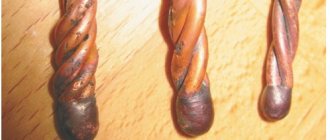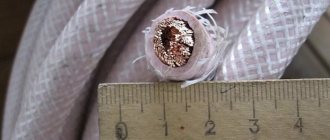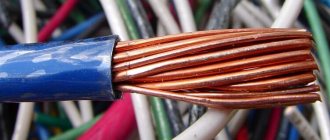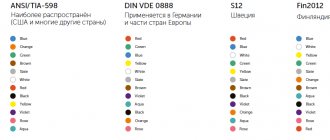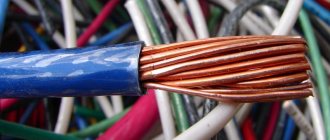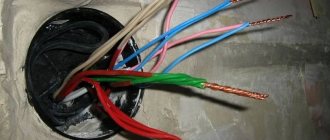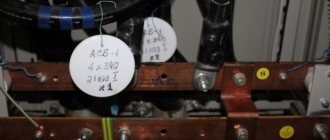The use of crimp connection terminals for wires is the switching of power cables, as well as in low-current circuits, where they are mandatory. During repairs, such wires can be easily disconnected. Experience in using various types of crimp terminals for connecting wires. Overview of ferrule crimping tools.
What is termination
Wire termination is one of the simplest and most reliable ways to connect wires to terminal blocks, circuit breakers and other electrical equipment. This type of connection is common in household and industrial networks. This is due to the advantages that termination allows to achieve:
- reliable contact patch;
- ease of installation;
- low connection resistance;
- general aesthetics of the wiring.
Power cables with lugs
The main advantage of terminating cable cores is the low contact resistance of the resulting contact. If it is not used, the wire will not be able to properly press the screw onto the terminal block bus. This will cause the contact resistance to be too high. A bad connection will start to heat up or completely burn out.
Termination is done using tips. Externally, they resemble copper or aluminum caps. On one side, a wire pre-stripped of insulation is inserted into them, and on the other there is a hole for fastening with a screw. The tip serves as a reliable adapter between the cable and the device to which it is connected.
Stranded wire crimping
Crimp terminals for wires
Crimp cable lugs or connection type wire terminals are designed for quick and reliable connection of wires in electrical circuits by clamping with insulation.
Ring
More reliable contact is provided by so-called ring terminals. Like their fork counterparts, they are designed to be subsequently secured with a screw clamp. But thanks to the round shape of the contact part, they provide a larger contact area and reduce the risk of tips “popping out”.
Ring terminals for wires are such a good solution that they are used not only in low-current networks, but are also a mandatory attribute of power cables of any cross-section. In this case, the method of attaching a wire or cable to lugs of this type can vary from welding and soldering to crimping.
Ring terminals are available in copper, aluminum, brass and copper-aluminium. Their cross-section can vary greatly, starting from small terminals for a C-grade screw and ending with bolts of 27 or more. In this case, terminals for low-current networks can be supplied with insulated crimp part.
Fork
Fork-type terminals are designed for switching power and secondary circuits. These lugs are designed for subsequent fastening with screws directly to equipment or busbars. The instructions advise using them as a temporary contact or requiring frequent reconnection.
The design of the fork ends is a two-pronged fork, hence the name. This design allows for fairly simple switching without completely unscrewing the screw clamp. At the same time, when connected, it provides a fairly tight contact.
Fork lugs are available for wires with a cross-section of up to 6 mm2. The wires are attached to the terminals using the crimping method. This place, in various variations, may or may not have an insulating coating.
Automotive
Automotive crimp terminals for wires: when working on a car, you often have to make various electrical connections using connectors or terminals. I decided for myself this way - if the connector is not sealed, but works in conditions of high humidity - only soldering. If the connector is sealed or located in the passenger compartment, then crimping can be used.
For non-insulated terminals, crimpers with a special jaw profile are used, which bend the ends of the metal inward during crimping. Such crimpers crimp the wire and additionally fix the insulation so that the wire does not break off due to kinks and vibration.
As experience shows, standard 6 mm automotive terminals require a crimper with jaws for a wire with a cross-section of 1.5 mm2, no less, otherwise the terminal and wire will be squeezed.
Why do you need an ending?
The danger lies in excessive overheating of the connection point. Without termination, the contact will be unreliable. Such a compound will begin to heat up and become covered with a layer of oxide. The resulting oxide will further increase the contact resistance. At the connection point, an increasing amount of heat will begin to be released. The process is like growing a snowball. But the result is the same - the connection will burn out.
And it’s good if the conductor simply falls off from its proper place and that’s all over. In some cases, the cable insulation may ignite due to overheating and cause a fire. And a fallen wire can touch the grounded body of the installation or electrical panel and cause a short circuit.
How to terminate a wire without a ferrule
Using lugs is a convenient way to terminate wires. However, they are not always at hand. In this case, the cable is terminated without lugs. The current-carrying conductor, stripped of insulation and dirt, is manually bent into the shape of a ring (ear) under the bolt. To form the joint, use long-nose pliers with a rounded outside. The resulting connection is less reliable than the factory-made tip.
If the wire is copper, then the eye for the bolt can be tinned with solder. It is necessary to bend the ring in the direction of tightening the screw, so that during the tightening process the eyelet twists around the bolt, and not vice versa.
Additional Information. Modern aluminum wire is not flexible. Its strands are more fragile than those of copper cable. This should be remembered when terminating and forming connecting rings. Aluminum wire must be bent a minimum number of times.
Common types of tips
In electrical installation practice there are dozens of types of connectors. This diversity is due to the wide list of wires used. Each type of cable has its own tip. It must match the material and cross-section of the current-carrying conductor.
Important. To terminate aluminum wires, adapters made of the same material should be used. This rule also applies to copper conductors. Direct connection of copper with aluminum is unacceptable.
Copper tips TM
Manufactured from seamless tube. This is indicated by the letter - T. The tube is made of copper - M. The full marking looks like this: TM 35-10-9. Here:
- T - tube;
- M - copper;
- 35 - cross-section of the cable for which this tip is intended, sq. mm;
- 10 — diameter (grade) of the fastening screw, mm;
- 9 is the diameter of the shank, that is, the hole into which the cable core is inserted.
If dimensions allow, the tip model is indicated on its surface. If it is too small, then the nominal cross-section of the connected cable is stamped on the product body. For example, the number “4” next to the mounting hole means that a conductor with a cross-section of 4 square meters should be inserted into the tip. mm.
Copper with tinning TML
Copper is a good conductor of electric current. However, a greenish coating is often found on TM tips. This is a layer of copper oxide, which is no good for reliable current transmission. To combat this phenomenon, the tips are additionally coated with a protective anti-corrosion tin coating. The resulting product here means tinning. Otherwise, the TM and TML markings are similar.
Tinned wire lugs
The protective layer prevents oxidation of the copper tip. Therefore, it can be used in more humid areas. Due to increased reliability, TML is suitable for connecting critical electricity consumers.
Tinned copper with control window TML (o)
Before installing the current-carrying conductor into the tip, the protective insulation layer is removed from it. There are a couple of subtleties:
- The stripped core should completely enter the tube and rest against its end. There should be no void left in the tip cavity.
- The cable must be stripped to a minimum length. So that there is no exposed section of wire without insulation left at the tip shank.
To control the above conditions, TML (o) connectors are used. The small letter “o” at the end of the marking means that there is an inspection hole on the surface. The window allows you to visually assess whether the cable has reached the proper depth.
Aluminum TA tips
This type of connector is made of aluminum tube. This is indicated by the letter "A". TA lugs are designed for branching aluminum wires from busbars of similar material.
TAs have a long service life. Aluminum has increased resistance to moisture from the air and is practically not destroyed by it. This material is several times cheaper than copper, so sometimes people choose aluminum fasteners.
Aluminum cable lugs
TA are produced for wires with a cross-section of 16 square meters. mm and above. They also require the use of quartz-vaseline lubricant for additional surface protection.
Copper-aluminum TAM
The structure of these connectors uses two metals: copper and aluminum. They are connected to each other through frictional diffusion. One metal penetrates another at the molecular level. Therefore, high contact resistance is avoided.
TAMs have a unique property. They are used to connect aluminum cores to copper busbars of switchgears. Otherwise, they are no different from other tubular modifications. A screw is used to connect them, and compression is done using a press.
Other types of tips
The types of fasteners listed are not sufficient to perform all electrical tasks. Therefore, in practice, other types of tips are often found:
- PM - cable lugs for soldering. They are made from sheet copper grade M1. In addition to soldering, this type of tip is also suitable for crimping. Available for cables with cross-sections from 2.5 to 240 sq. mm.
- NShP - pin flat. Used to connect copper cables. Made of copper. The main purpose is to connect wiring to circuit breakers. Inside it has ring notches to improve contact with the current-carrying conductor.
- NShV - pin bushing. Common in modern equipment. Made of electrical copper with a protective coating. Used to connect multi-core copper wires with a cross-section from 0.25 to 150 square meters. mm.
- NSHVI - insulated pin bushing. Equipped with an additional insulating plastic skirt.
Types of wire terminals
A terminal is a contact element that is designed to detachably connect conductors to each other.
Connections when constructing electrical circuits can be made using different methods, and terminals are just one of the options. However, this option seems to be the simplest, most convenient and even economical compared to, for example, soldering and welding, including cold welding.
- When faced with the need to select electrical terminals for wires, it is better to start with the simplest designs of domestic production - reliable, durable, proven in practice more than once:
- knife;
- fork;
- ring;
- pin
Finishing tools
To securely crimp the tube under the cable, you will have to use a special tool. Depending on the cable cross-section, it is divided into two categories:
- press pliers - for tips up to 10 sq. mm;
- hydraulic press - from 16 sq. mm and above.
Wire terminations ensure uniform crimping of the tube on at least four sides. This method allows you to achieve the best contact. The hydraulic press comes with compression attachments. They should be selected depending on the cross-section of the crimped tip.
Hydraulic press pliers for crimping lugs
Important! After crimping the tip, it should be protected from moisture from the air. Several layers of insulating PVC tape are wound around the area into which the wire is inserted. It is even more convenient to use heat-shrinkable tubing. Its color is selected in accordance with the purpose of the wire. Phase A - yellow, B - green, C - red.
Soldering tips
Some tips require fastening by soldering. As a rule, these models are produced in tinned version. If the tip is designed for a small cross-section of up to 10 sq. mm, then it can be soldered using a regular soldering iron. If the tube is large, then you should use a gas burner. In this case, the conductor itself is first cleaned and tinned with tin-lead solder. The method is only suitable for copper lugs and cables. In terms of quality, such a connection is inferior only to welding.
Reliable connection of the cable requires termination of its cores. For large cross-section wires, lugs should be used. Thin ones can be terminated without them. To do this, just make a neat ring using long-nose pliers or pliers.
The tip is selected taking into account the material and cross-section of the current-carrying conductor. For high-quality termination, it is advisable to use a special press or assembly pliers. If they are absent or the amount of work is small, it is permissible to resort to soldering the tip.
Why are they needed?
Wire lugs are needed to perform crimping of NShVI, to create reliable contact between several conductors, wires and busbars, or wires and clamps. Electrical contact in such a situation will be ensured by complete contact of the walls of the cable lug along the core diameter using a hammer or clamping using a screw device. They are also needed to simplify installation processes in electrical installations or to perform some technological operations.
Cable lugs for crimping
Cable lugs for automotive wires for crimping are designed to replace all kinds of twists and other types of connections that are common among poor installers. Such a device allows for optimal wire fixation inside the sleeve or a reliable conductor.
Crimping



